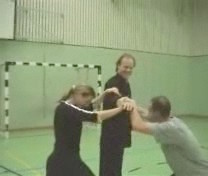HOW DOES CHI RELATE TO MUSCLES IN INTERNAL FORCE TRAINING

Why are big muscles not desirable in kungfu, and for what reason?
Question
With regards to lifting weights to train internal force, as well as just about any other activity, how does chi relate to muscles? I know that large muscles can take a lot of energy to maintain, and that tense muscles can lock up chi. However, my Western mindset tells me that muscles are a necessary part of moving. Is it possible to move without muscles? Does practicing Shaolin Kungfu cause one's body to have the optimal amount of muscle, not too much and not too little? Am I causing myself confusion by combining two different paradigms?
-- Sifu Matt Fenton
Answer
You have raised a very interesting point regarding internal force and the use of muscles. I believe no one has explained this point before. I have not read anything about it in classics or modern writing. My answer, therefore, is probably unprecedented. It is based on my experience as well as my understanding of force training philosophy.
When we say, "Don't use your muscles" we are speaking provisionally. What we mean is that we do not tense our muscles. In the same way, when we say that a person's energy is blocked, we mean that it is relatively blocked. There is still some energy flowing.
You are right -- muscles are necessary for movement. Even when we use internal force, muscles are involved. One cannot move without muscles. But we do not tense our muscles in the way when external martial artists use muscular strength.
But this does not mean that the muscles are listless. The muscles are also taut, but we do not use the term "tensed" as it may give a wrong connotation. The muscles are taut, without being tensed, because they are charged with flowing energy.
Herein lies the big difference. When one tenses his muscles, they become taut because energy is locked up in the muscles. Moving the muscular mass with speed provides muscular strength.
When we use internal force, we relax our muscles and let energy flow through them. The muscles also become taut, not because of tension but because they are charged with energy. The flowing energy provides internal force.
The concept may become clearer if we use an analogy. An empty water hose is listless. It becomes taut when we fill it with pieces of solid ice. This corresponds to muscular strength.
The water hose can also become taut when we fill it with flowing water. This corresponds to internal force.
The solid ice in the water hose is "dead". Its use is limited to making the water hose taut to produce mechanical strength. After some time it becomes stale.
The flowing water in the water hose is "alive". Its use is holistic. Besides making the water hose taut to produce internal force, it can also be used for many other purposes wherever it flows to. It is always fresh and constantly re-charged.
Yes, practicing Shaolin Kungfu or Taijiquan can result in the optimal amount of muscles. You are not causing confusion. In fact your questions open a new vantage point concerning muscles, mechanical strength, energy flow and internal force. It is questions like yours that enable us to understand our arts more deeply, helping us to obtain better result in less time.
-- Grandmaster Wong Kiew Kit

It is flowing chi that provides the internal force making Sifu Andrew Barnett's arm unbendable
The above is reproduced from the thread 20 Questions for Grandmaster: Choy-Li-Fatt and Kungfu against Other Styles in the Shaolin Wahnam Discussion Forum.

LINKS
